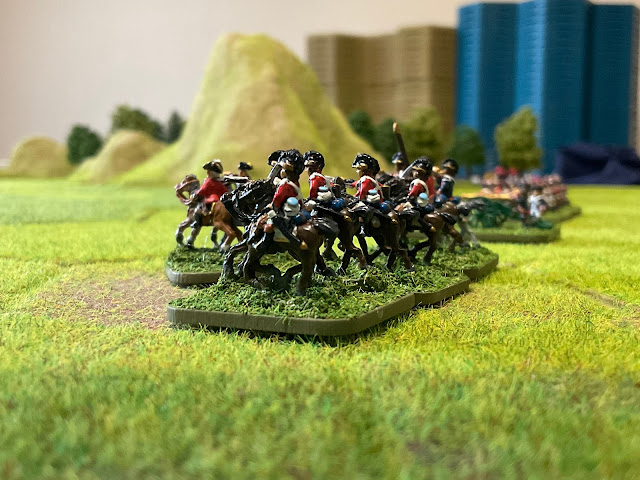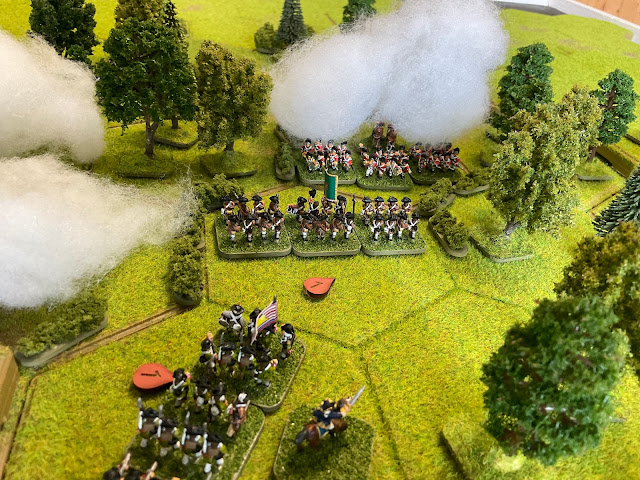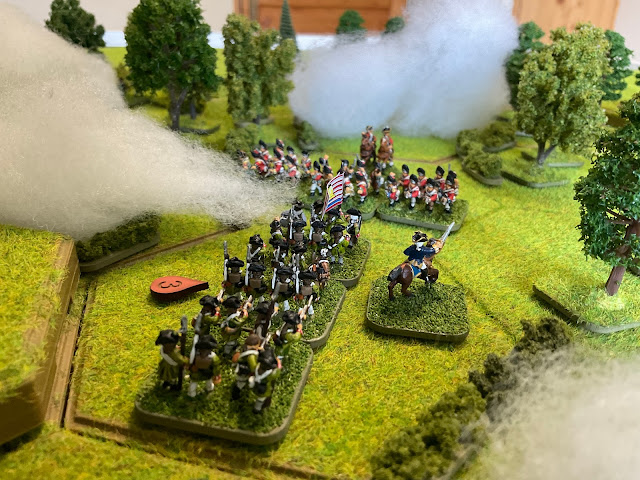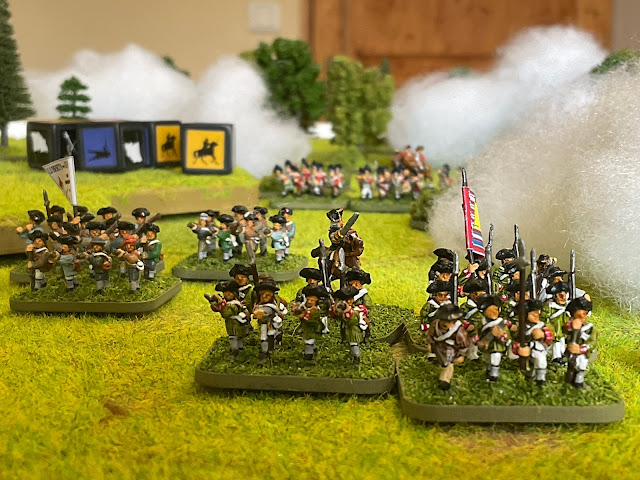This post covers the events in my ongoing mini AWI campaign.
American General Cummings has been tasked with defending coastal artillery intended to interdict British supplies sailing around the Owl Head Peninsula to Coldstream.
His opponent, General Parrott has been tasked with destroying the coastal guns in order that supplies essential to operations in the theatre are received intact.
The British troops had enjoyed overwhelming success at the first encounter with the Americans, causing the rebels to flee with heavy losses after a surprise encounter on the O’Higgins trail.
Now read on…
General Cummings was a bit taken aback by the sudden and violent overthrow of his three militia battalions at the hands of General Parrott’s grenadiers but in one sense at least the militia’s mission had proved a partial success - they had located the advancing British army.
By contrast General Parrott, if you’ll excuse the avian analogy, was now “cock a hoop”. The rebels had scattered like chaff in the wind before him. If that was the best the Americans could do he clearly had little to fear.
The issuing of promissory notes to prop up his supply shortfall has been mentioned in the previous post and was an out of the box bit of sophistry that I couldn’t help but applaud. What I never reckoned on however was the interplay with other random game events because on the next turn the Americans got “spies” who revealed the British players last instructions to me as the GM; the instruction to issue the promissory notes.
The narrative I subsequently presented to Graham as the American supremo, was that his patrols had intercepted a number of farmers travelling south with wagon loads of supplies, clutching Chris’s promissory notes. He was asked if he wanted to string them up after taking the supplies or just let them go. Mindful of the farmers inherent loyalist sympathies, he decided to let them go…and pay them out of his own pocket for the supplies he’d taken.
Masterful.
His clemency went a long way to shaking the farmers unthinking support for the crown - though worse was to follow for poor old Chris since the farmers at Arrowhead were now prepared to sell supplies to the Americans for hard cash instead of bits of paper. This was also the point at which his decision to arm the friendly Cherokee came back to bite him in the ass.
Having been informed that his promissory notes and supplies would not be waiting for him at Trappers Landing after all, General Parrott changed his plans to head there and instead ordered his men directly west towards the expected position of the coastal guns he’d been tasked with locating and destroying.
News of the militias rough handling by the grenadiers quickly spread to the sympathetic trappers and hunters who had a trading outpost down at Trappers Landing. Incensed at the actions of the British troops, many of the backwoodsmen decamped to swell the militias depleted ranks.
The militia bested by Chris’s grenadiers had been heading west and had managed to stay just ahead of the British as reinforcements started to trickle in. By the 5th July dire news reached the Americans from Arrowhead - which had come under attack from the newly armed Cherokee. The supplies they were about to sell to the Americans had been destroyed. What could be done? General Cummings immediatly split the retiring militia group into two, allowing the weakest battalion to head up to Arrowhead to protect the villagers and the two remaining militia groups to retire towards the fortifications that his subordinate (General Motte) had been building around the coastal guns.
Good news for the Americans came later on the 5th - the random events die roll had produced “reinforcements”. A battalion of South Carolina Provincial infantry had been ferried across the river from the south and were disembarking at Trappers landing. As they disembarked and began to march north, fresh sails could be seen arriving in the estuary. British ships!
Frustrated by the militia slipping away and the failure of his promissory note issue, General Parrott decided to issue a proclamation to the slaves working on the settlers farms. If they escaped their masters and brought supplies to Trappers Landing they would be granted their freedom and protected by the crown.
On the surface this seemed like a great ploy. It would pay back the settlers for their disloyalty, and potentially still bring in some of the supplies his force badly needed.
Once again the dice Gods punished Chris. The farms at Arrowhead were small and though slaves were held there, there weren’t as many of them as he’d imagined. The attacks by the Cherokee had hardened the farmers hearts and the arrival of the militia sent to protect the settlement helped stifle any idea of a slave revolt.
At this point, when I thought fate couldn’t get any worse for the British, it naturally did.
As part of the initial campaign information the players were both given a bit of background on their two immediate subordinates. General Parrott had this pair:
Colonel Montague Mountjoy Sykes (2nd Baronet of Lulworth), and Lt Col Parsifal Matthews (KB).
The back story for Sykes was that he socially outranked Parrott but had been passed over for command of the current expedition and was not a happy bunny. None of that would have mattered a jot had Chris’s next random event roll not been “command friction” which took him off down a whole other rabbit hole.
Chris was advised that Sykes had been outraged by the decision to free the slaves and he’d written to Sir Henry Clinton the theatre commander to complain. Clinton duly despatched a note to general Parrott telling him that the proclamation must be rescinded immediatly. How did Chris want to deal with such an unruly subordinate I asked? Ignore it? Ride over to the mans location and confront him? Maybe he wanted to suggest something else?
What Chris didn’t know was that riding over to confront the chap had a decision tree outcome of a major argument potentially leading to a duel. Lol. Ever the diplomat, Chris actually chose to write a brilliant letter to Sykes putting him in his place and gently reaffirming who was in charge. It seemed to do the trick because further orders were subsequently followed, (though to General Parrott’s letter there was ominously no reply).
As the British pressed ever westward one of their pre game cunning plans finally came to fruition as the 33rd infantry disembarked from navy frigates at Trappers Landing. Even this coup de main was slightly tarnished by the discovery that the American provincial reinforcements had landed in the same spot the turn before and though already marching away he knew they could still turn to present an imminent threat. Rather than striking north, General Parrott ordered his new arrivals to start building defences.
General Cummings was all too aware that the British were closing in on the coastal gun positions and he ordered all his dispersed sub commands to move towards this location in order to defend them. His random event Die Roll produced “terrain” allowing him to choose a strategic map hex and add either fortifications, swamps or make it impassable. Graham chose swamps and nominated a hex he thought the British might attempt to traverse on their march.
On the 7th - General Parrott’s luck seemed to change. The 16th Dragoons arrived through a “reinforcement” random event adding to his forces in the nick of time.
 |
| The 16th Dragoons arrive in the nick of time. |
Ordering his reinforced column of grenadiers artillery and dragoons forward to the coast he was unaware that Sykes with two elite battalions of light bobs had been delayed after stumbling into the uncharted marshland. Approaching the guns at Pringles Point, General Parrott found himself having to go it alone.
Defending the guns against Parrott’s grenadiers, artillery and dragoons were two battalions of militia a battery of guns and the coastal artillery which General Motte had ordered to be dragged around to face the oncoming attackers. Even ensconced behind their earthen barricades it was going to be touch and go.
 |
| The bulk of the Americans behind their earthwork defences. A second militia battalion occupies a horse shoe redoubt out of sight to the right. |
Could Parrott drive the rebels off and nullify the threat to the approaching British convoy of supply ships?
 |
| The grenadiers prepare to advance on the rebel fortifications. |
We’ll find out shortly.
Todleooh.













